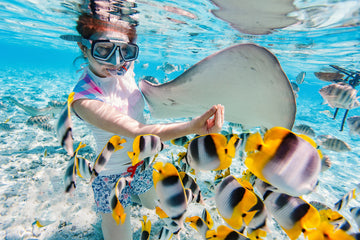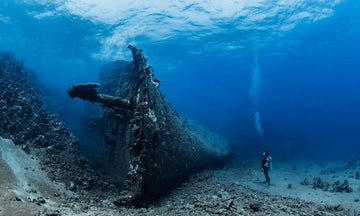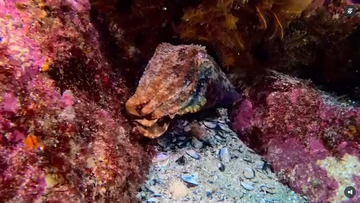For newcomers to scuba diving with a dream of exploring the underwater world, the first experience is a mixture of excitement and apprehension. Both longing for the encounter with the mysterious seabed, but also worried about the lack of preparation and let the good discount. After all, scuba diving equipment is not just something you wear, but also a key partner in ensuring safety and enhancing the experience. Each piece of equipment contains unique design wisdom and practical value, only in-depth understanding and skilful use, in order to swim in the underwater world without worry. Today, let's unveil the mystery of these basic equipment and explore their unique features and important uses.
Submersible Cylinders: The Intelligent Choice for the Source of Life
Diving cylinders are an indispensable ‘source of life’ in the wonderful journey of scuba diving. Commonly used high pressure oxygen cylinders are made of aluminium or steel, sturdy and able to withstand strong pressure, with a common volume of 10-15 litres. Instead of pure oxygen, the cylinder is filled with carefully blended compressed air, usually consisting of 21% oxygen and 79% nitrogen, or other suitable gas mixtures. Why not use pure oxygen? There are important safety considerations hidden behind this. Prolonged inhalation of pure oxygen triggers the risk of oxygen toxicity. Medically, inhaling pure oxygen for short periods of time can help heal the body in certain specific situations, but in scuba diving, pure oxygen becomes a potential hazard when the water depth exceeds 6 metres. For example, a scuba diver once attempted to dive with pure oxygen in deeper waters without fully understanding the dangers of pure oxygen. As a result, he suffered from convulsions shortly after being underwater. Fortunately, his travelling companion found him in time and brought him to the surface, thus avoiding a tragedy. Oxygen cylinders filled with compressed air have therefore become ideal for recreational diving, while for technical diving, gas mixtures such as helium are added to the cylinders to effectively reduce the risk of nitrogen narcosis during deeper dives and to protect the diver.
Buoyancy control devices: masters of the art of underwater balance
In the world of diving, buoyancy control is a subtle art, and buoyancy control devices are a key tool in mastering this art. The buoyancy factor, a seemingly technical term, is actually very relevant to the diver's experience. It refers to the effect of gas compression or expansion on the buoyancy of the diver and equipment at a certain depth, and is commonly used to calculate the change in buoyancy of cylinders, BCs (Buoyancy Compensators) or the diver as a whole at different depths. The magic of the buoyancy control device is that it helps the diver to maintain neutral buoyancy, allowing us to swim like a fish in the water and to control the lift and balance of the body with ease. Modern buoyancy control devices incorporate advanced design concepts, integrated weighting systems and multiple adjustment points for the ultimate in diver comfort. Some models are also equipped with a quick-release mechanism that responds quickly in case of an emergency to ensure the diver's safety. For example, an experienced diver was suddenly hit by an underwater current during a dive and lost his balance. At this point, he quickly used the quick release function of the buoyancy control device to adjust his buoyancy status, successfully escaping the impact of the underwater current and safely completing the dive.
Regulators: safe guarding between breaths
The regulator, as the core equipment of scuba diving, is like a silent guardian of the ‘respiratory guard’, whose performance is directly related to the safety and comfort of diving. It usually consists of a primary head and a secondary head, and some systems are equipped with a spare secondary head and a low-pressure inflator tube, each in its own way, working in tandem. The primary head is connected to the cylinder valve and acts as a ‘pressure-reducing transformer’, lowering the high pressure gas in the cylinder to medium pressure in preparation for the subsequent breathing process. The second stage head is the bridge between the diver and the outside air, which further reduces the medium pressure gas to ambient pressure for the diver to breathe smoothly. The backup second stage head, usually highlighted in yellow or red, provides a reliable emergency air supply in case of an emergency. The low pressure inflation hose then connects the first stage head to the drysuit and controls buoyancy by inflating and exhausting the gas to keep the diver in optimum condition under water. To ensure the reliability of the regulator, regular maintenance and inspection are essential. Meticulous inspection before each dive is a responsibility for your own life and safety, as well as a sign of respect for this mysterious underwater world. There was once a novice diver who, due to not checking the regulator on a regular basis, had a sudden malfunction of the secondary head during a dive and could not supply air properly. Fortunately, he found it in time and used the spare second stage head before he was able to return to the surface safely. This example fully illustrates the importance of regular maintenance and inspection of equipment.
Masks: a clear window to underwater vision
Diving mask, like the diver's ‘underwater eyes’, directly affects the clarity of vision, comfort and safety. A suitable mask allows the diver to clearly appreciate the colourful corals, dynamic fish and mysterious underwater landscape. The main function of a mask is to isolate the eyes and nose, providing a clear viewing environment for the diver, while balancing the pressure and protecting the face from the impact of water pressure and currents. When choosing a mask, a high-volume mask made of single-lens silicone is a good choice, which not only has a wide field of vision and allows divers to feel the charm of the seabed in all directions, but also has excellent comfort and reduces the discomfort caused by wearing it for a long time. For example, after using a low quality mask, a diver's vision and mood were affected by the poor sealing of the mask, which led to water seeping in constantly during the dive. After replacing his mask with a high-volume mask made of single-lens silicone, his diving experience was greatly improved and he was able to concentrate more on enjoying the underwater scenery.
Flippers: the power engine of underwater propulsion
The flippers are the ‘power engine’ of a diver's journey in the water, and their presence directly affects swimming efficiency, physical exertion and manoeuvrability. At the same time, it also protects the feet and reduces the risk of contact with coral, rocks and other sharp objects, providing a guarantee for the safety of divers. There are three main types of flippers: full-footed flippers are lightweight and flexible, and can be used directly on the feet, but with poor warmth; open flippers need to be paired with dive boots, and the adjustable strap design makes them more adaptable while providing some warmth; and free-diving long flippers are known for their extra-long blades (80cm+), which have a very high propulsive efficiency, but also require a higher level of skill on the part of the user. For recreational scuba diving, the composite fibre medium durometer open flippers are a good choice, which find a perfect balance between efficiency and comfort, effectively reducing leg fatigue and making the diving trip more relaxing and enjoyable. When a novice diver first used the freediving flippers, due to unskilled technique, he not only swam inefficiently, but also consumed a lot of physical strength, resulting in a much shorter dive time. After replacing his flippers with composite fibre medium durometer open toe flippers, his diving experience was significantly improved and he was able to swim in the water more easily.
Diving snorkel: the intimate assistant for surface breathing
The snorkel, as an auxiliary equipment for snorkelling and scuba diving, may seem inconspicuous, but it has an indispensable role to play. When breathing at the surface, the diver does not need to lift his head frequently, which saves air in the cylinder and improves the safety of diving. In emergencies such as regulator malfunctions, snorkels can also temporarily act as a breathing apparatus, providing divers with valuable emergency support. Comfort is a primary consideration when choosing a snorkel. The mouthpiece needs to be soft and snug to avoid fatigue of the dental bed caused by prolonged use; the diameter of the tube should be moderate, too thick will increase the breathing resistance, too fine may lead to insufficient oxygen supply; the length of the tube should be less than 40cm, too long will make the exhaust gas residual, affecting the quality of breathing. Once a diver in a diving activity, regulator sudden failure, in the emergency, he quickly picked up the breathing tube for breathing, successfully swam back to the surface, to avoid a dangerous occurrence. This fully embodies the importance of the breathing tube in the diving process.
Wetsuits, drysuits and skins: choices for warmth and protection
Wetsuits are not only ‘armour’ against the cold, they are also intimate protection against abrasions. For ice diving and technical diving, dry suits are the way to go, as they keep your body warm by insulating it from the cold currents. However, the use of a dry suit requires specialised training in techniques such as inflation control and emergency venting to ensure safety and comfort underwater. For tropical divers, thinner wetsuits or skins (1mm-3mm) are more suitable, as they are lightweight and flexible and do not interfere with the diver's manoeuvres. For recreational divers, a 3-5mm wetsuit is a good choice, providing some warmth and a high degree of flexibility, allowing divers to move freely through the water and enjoy the fun of diving. For example, a tourist diving in tropical waters, wearing a thinner wetsuit, can easily dance with the tropical fish and feel the vitality and energy of the seabed. Another professional diver diving in cold waters, wearing a dry suit, is able to keep his body warm even in low temperatures and focus on exploring the mysterious underwater world. Each piece of equipment for scuba diving unites wisdom and craftsmanship, and they work together to guard the safety and dreams of divers. Understanding these equipments is not only for a perfect diving experience, but also respect and awe for yourself and this mysterious underwater world. May every diving enthusiast be able to start their own wonderful underwater journey with the help of the equipment.






cxy1tw
cxy1tw
qxhwnj